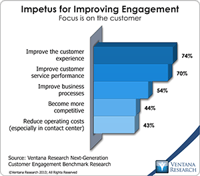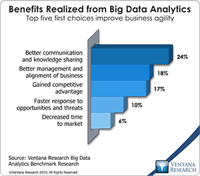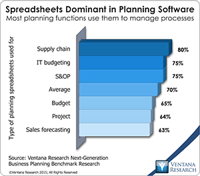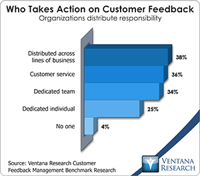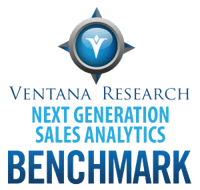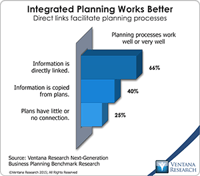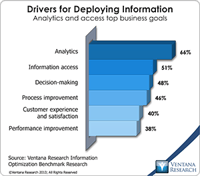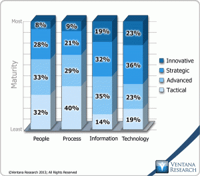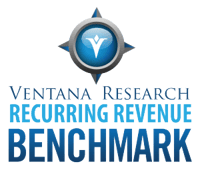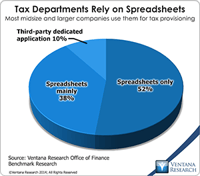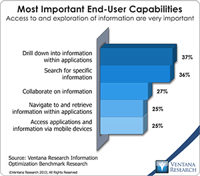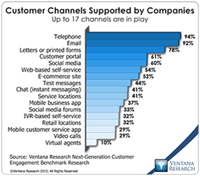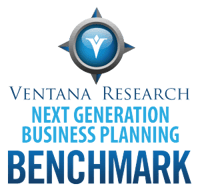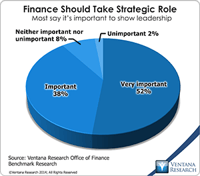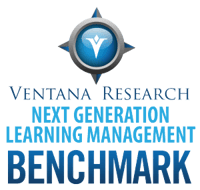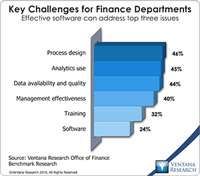Competition for customers is more intense today than ever before, and companies struggle to differentiate themselves from the competition. Our research repeatedly finds that customer experience is a key differentiator. Our research into next-generation customer engagement said the impetus for improving engagement is to improve the customer experience in almost three quarters (74%) of participants. One increasingly popular way to do this is to use customer journey maps, which show how companies...
Read More
Topics:
Big Data,
Customer Analytics,
Customer Experience,
Customer Feedback Management,
Speech Analytics,
Customer Performance,
Analytics,
Cloud Computing,
Customer Service,
Call Center,
Contact Center,
Contact Center Analytics,
CRM,
Text Analytics
In many organizations, advanced analytics groups and IT are separate, and there often is a chasm of understanding between them, as I have noted. A key finding in our benchmark research on big data analytics is that communication and knowledge sharing is a top benefit of big data analytics initiatives, but often it is a latent benefit. That is, prior to deployment, communication and knowledge sharing is deemed a marginal benefit, but once the program is deployed it is deemed a top benefit. From...
Read More
Topics:
Big Data,
Predictive Analytics,
Sales Performance,
Supply Chain Performance,
alpine data labs,
Customer Performance,
Operational Performance,
Analytics,
Business Analytics,
Business Intelligence,
Business Performance,
Financial Performance,
Strata+Hadoop
In our benchmark research at least half of participants that use spreadsheets to support a business process routinely say that these tools make it difficult for them to do their job. Yet spreadsheets continue to dominate in a range of business functions and processes. For example, our recent next-generation business planning research finds that this is the most common software used for performing 11 of the most common types of planning. At the heart of the problem is a disconnect between what...
Read More
Topics:
Planning,
Sales Performance,
ERP,
Forecast,
GRC,
Office of Finance,
Reporting,
closing,
dashboard,
enterprise spreadsheet,
Excel,
Customer Performance,
Operational Performance,
Analytics,
Business Analytics,
Business Collaboration,
Business Intelligence,
Business Performance,
Financial Performance,
Information Management,
Data,
Risk,
application,
benchmark,
Financial Performance Management
Verint entered the enterprise market for customer feedback management when it acquired Vovici in August 2011. Since then the Vovici products have been integrated into Verint’s Customer Engagement Optimization suite, which includes products originally developed by Verint and Kana, which it also acquired. The current suite supports a range of capabilities that Verint groups into three categories: customer analytics (various types of analytics and Enterprise Feedback Management), customer...
Read More
Topics:
Big Data,
Customer Analytics,
Customer Experience,
Customer Feedback Management,
Speech Analytics,
Customer Performance,
Analytics,
Business Analytics,
Cloud Computing,
Customer Service,
Call Center,
Contact Center,
Contact Center Analytics,
Text Analytics
All lines of business are under pressure to meet targets and deliver expected results, but none is under more pressure than Sales. Like other organizations it must use information to derive insights about progress and problems and to decide what changes to make. Today businesses collect and analyze data from more data sources in more forms than ever before. To understand it they need effective analytics, and again none need it more than Sales.
Read More
Topics:
Big Data,
Sales,
Sales Performance,
Operational Performance,
Business Analytics,
Business Collaboration,
Business Intelligence,
Cloud Computing,
Financial Performance,
Information Applications,
Sales Performance Management,
SFA
Ventana Research recently released the results of our Next-Generation Business Planning benchmark research. Business planning encompasses all of the forward-looking activities in which companies routinely engage. The research examined 11 of the most common types of enterprise planning: capital, demand, marketing, project, sales and operations, strategic, supply chain and workforce planning, as well as sales forecasting and corporate and IT budgeting. We also aggregated the results to draw...
Read More
Topics:
Big Data,
Planning,
Predictive Analytics,
Sales,
Sales Performance,
Social Media,
Supply Chain Performance,
Human Capital Management,
Marketing,
Office of Finance,
Reporting,
Budgeting,
Controller,
Customer Performance,
Operational Performance,
Business Analytics,
Business Performance,
Cloud Computing,
Financial Performance,
In-memory,
Workforce Performance,
CFO,
Supply Chain,
capital spending,
demand management,
Financial Performance Management,
financial reporting,
FPM,
Integrated Business Planning,
S&OP
Maximizing the performance and value of people in the workforce should be a primary focus for any business these days. It is a complex task, especially for larger organizations, and chances for success can be increased by investment in human capital management (HCM) applications. In this competitive software market SAP is making a strong push, aided by acquisitions in the last three years of SuccessFactors for talent management and more recently Fieldglass for contingent labor management....
Read More
Topics:
SAP,
HCM,
Human Capital Management,
Learning,
Performance,
Recruiting,
SuccessFactors,
Operational Performance,
Analytics,
Business Analytics,
Business Performance,
Cloud Computing,
Financial Performance,
Compensation,
HRMS,
Vendor Management Systems,
Workforce Analytics,
Workforce Management,
Workforce Planning
Data is an essential ingredient for every aspect of business, and those that use it well are likely to gain advantages over competitors that do not. Our benchmark research on information optimization reveals a variety of drivers for deploying information, most commonly analytics, information access, decision-making, process improvements and customer experience and satisfaction. To accomplish any of these purposes requires that data be prepared through a sequence of steps: accessing, searching,...
Read More
Topics:
Big Data,
Sales Performance,
Supply Chain Performance,
Customer Performance,
Operational Performance,
Analytics,
Business Analytics,
Business Collaboration,
Business Intelligence,
Business Mobility,
Business Performance,
Cloud Computing,
Data Preparation,
Financial Performance,
Information Applications,
Information Management,
Location Intelligence,
Operational Intelligence,
Workforce Performance,
Information Optimization
The idea of not focusing on innovation is heretical in today’s business culture and media. Yet a recent article in The New Yorker suggests that today’s society and organizations focus too much on innovation and technology. The same may be true for technology in business organizations. Our research provides evidence for my claim.
Read More
Topics:
Big Data,
Sales,
Customer Performance,
Operational Performance,
Analytics,
Business Analytics,
Business Intelligence,
Business Performance,
Financial Performance,
Information Management
Recurring revenue is a term applied to business models that involve three types of selling and billing structures: a one-time transaction plus a periodic service charge; subscription-based services involving periodic charges; or a contractual relationship that charges periodically for goods and services. Telecommunications was the first major industry to use it, but recently the model has gained popularity in others. It is a major trend in information technology as an increasing number of...
Read More
Topics:
SaaS,
Customer Experience,
NetSuite,
Office of Finance,
Recurring Revenue,
Zuora,
Customer Performance,
Business Performance,
Cloud Computing,
Customer Service,
Financial Performance,
billing software,
Intacct
At its annual MicroStrategy World conference, this provider of analytics and business intelligence systems for business and IT introduced a new version of its flagship product, MicroStrategy 9s. Among many advances it adds enterprise grade security with MicroStrategy Usher as part of the maintenance update to its 9.4.1 release. Security is increasingly critical for analytics and BI. Technologies that work intensively with data, including reporting, business intelligence, analytics and data...
Read More
Topics:
Big Data,
Mobile,
Sales Performance,
Governance,
Operational Performance,
Analytics,
Business Analytics,
Business Collaboration,
Business Intelligence,
Business Mobility,
Business Performance,
Cloud Computing,
Customer & Contact Center,
Information Applications,
Information Management,
Risk & Compliance (GRC),
Security
Most people in business management admit that sales is more an art than a science. Organizations have long struggled to find the right mix to improve its effectiveness, and few get the most out of available technology. For many the default is still to use sales force automation (SFA) and spreadsheets to manage processes and try to increase the productivity of sales staff. In our view they should take a holistic approach to sales processes from contact to close and support everything from sales...
Read More
Topics:
Sales,
Recurring Revenue,
Sales Compensation,
Sales Forecasting,
Customer Performance,
Business Collaboration,
Business Mobility,
Cloud Computing,
CRM,
SFA
One of the issues in handling the tax function in business, especially where it involves direct (income) taxes, is the technical expertise required. At the more senior levels, practitioners must be knowledgeable about accounting and tax law. In multinational corporations, understanding differences between accounting and legal structures in various localities and their effects on tax liabilities requires more knowledge. Yet when I began to study the structures of corporate tax departments, I was...
Read More
Topics:
Big Data,
ERP,
Governance,
GRC,
Office of Finance,
audit,
finance transformation,
LongView,
Tax,
Analytics,
Business Analytics,
Business Performance,
Financial Performance,
Information Management,
Oracle,
CFO,
Risk & Compliance (GRC),
Vertex,
FPM,
Innovation Awards,
Thomson-Reuters multinational
Oracle is one of the world's largest business intelligence and analytics software companies. Its products range from middleware, back-end databases and ETL tools to business intelligence applications and cloud platforms, and it is well established in many corporate and government accounts. A key to Oracle's ongoing success is in transitioning its business intelligence and analytics portfolio to self-service, big data and cloud deployments. To that end, three areas in which the company has...
Read More
Topics:
Big Data,
Customer Performance,
endeca,
OBIEE,
OBIFS,
Analytics,
Business Analytics,
Business Collaboration,
Business Performance,
Cloud Computing,
Oracle
I recently attended a Cisco Collaboration analyst day in the U.K. and was impressed by what I heard and saw.Cisco of course is known as a supplier of network equipment and software, and it has long provided these through a global network of partners. But Cisco also has been in the contact center market for several years and has had success with its small and enterprise contact center systems, having more than 20,000 on-premises customers and revenue in excess of US $1.5 billion. Cisco markets...
Read More
Topics:
Big Data,
Customer Analytics,
Customer Experience,
Speech Analytics,
Analytics,
Business Collaboration,
Cloud Computing,
Customer & Contact Center,
Customer Service,
Call Center,
Contact Center,
Contact Center Analytics,
Text Analytics
Big data has become a big deal as the technology industry has invested tens of billions of dollars to create the next generation of databases and data processing. After the accompanying flood of new categories and marketing terminology from vendors, most in the IT community are now beginning to understand the potential of big data. Ventana Research thoroughly covered the evolving state of the big data and information optimization sector in 2014 and will continue this research in 2015 and...
Read More
Topics:
Big Data,
MapR,
Predictive Analytics,
Sales Performance,
SAP,
Supply Chain Performance,
Human Capital,
Marketing,
Mulesoft,
Paxata,
SnapLogic,
Splunk,
Customer Performance,
Operational Performance,
Business Analytics,
Business Intelligence,
Business Performance,
Cloud Computing,
Cloudera,
Financial Performance,
Hortonworks,
IBM,
Informatica,
Information Management,
Operational Intelligence,
Oracle,
Datawatch,
Dell Boomi,
Information Optimization,
Savi,
Sumo Logic,
Tamr,
Trifacta,
Strata+Hadoop
Business planning includes all of the forward-looking activities in which companies routinely engage. Companies do a great deal of planning. They plan sales and determine what and how they will produce products or deliver services. They plan the head count they’ll need and how to organize distribution and their supply chain. They also produce a budget, which is a financial plan. The purpose of planning is to be successful. Planning is defined as the process of creating a detailed formulation of...
Read More
Topics:
Big Data,
Planning,
Predictive Analytics,
Sales Performance,
Supply Chain Performance,
Human Capital,
Marketing,
Office of Finance,
Reporting,
Sales Forecasting,
Budgeting,
Operational Performance,
Analytics,
Business Analytics,
Business Collaboration,
Business Performance,
Customer & Contact Center,
Financial Performance,
Business Planning,
Supply Chain,
Demand Planning,
Integrated Business Planning,
Project Planning,
S&OP
Managing investments in people and their performance is critical to every organization. It also is complicated. To support the various aspects of human capital management (HCM), organizations often use a variety of technology including systems for human resource management, talent management, workforce management and payroll management. Often these separate systems use their own information and are not well connected to each other. Today they are deployed both on-premises and in cloud computing...
Read More
Topics:
Supply Chain Performance,
HCM,
Human Capital,
Human Capital Management,
Operational Performance,
Business Performance,
Customer & Contact Center,
Financial Performance,
HRMS,
Talent Management,
Workforce Management
Last year Ventana Research released our Office of Finance benchmark research. One of the objectives of the project was to assess organizations’ progress in achieving “finance transformation.” This term denotes shifting the focus of CFOs and finance departments from transaction processing toward more strategic, higher-value functions. In the research nine out of 10 participants said that it’s important or very important for the department to take a more strategic role. This objective is both...
Read More
Topics:
Big Data,
Planning,
Predictive Analytics,
Governance,
GRC,
Office of Finance,
Budgeting,
close,
end-to-end,
Tax,
Tax-Datawarehouse,
Analytics,
Business Performance,
CIO,
Financial Performance,
In-memory,
CFO,
CPQ,
Risk,
CEO,
Financial Performance Management,
FPM
As organizations look to improve the competency and skills of their workers, learning management system (LMS) technology can help improve their efforts. Our latest benchmark research in next-generation learning management systems finds a range of progress in this regard. Our Performance Index analysis places organizations almost evenly between the two lowest (51%) and the two highest (49%) of four levels of performance. The results differ by size of company as measured by number of employees....
Read More
Topics:
HCM,
Human Capital,
Human Capital Management,
LMS,
Learning Management,
Operational Performance,
Business Performance,
HR,
Talent Management
Our recently published Office of Finance benchmark research assesses a broad set of functions and capabilities of finance organizations. We asked research participants to identify the most important issues for a finance department to address in a dozen functional areas: accounting, budgeting, cost accounting, customer profitability management, external financial reporting, financial analysis, financial governance and internal audit, management accounting, product profitability management,...
Read More
Topics:
Mobile,
Planning,
Predictive Analytics,
ERP,
FP&A,
Office of Finance,
Reporting,
Self-service,
Budgeting,
close,
closing,
computing,
Controller,
dashboard,
Tax,
Analytics,
Business Intelligence,
Business Performance,
Cloud Computing,
Collaboration,
Financial Performance,
CFO,
Data,
finance,
Financial Performance Management,
FPM,
Microsoft Excel,
Spreadsheets
This year presents much opportunity for organizations to use a new generation of technology to compete better, be more efficient in their business operations and engage their workforces to their full potential. We have identified and begun to track the following next-generation technologies: analytics, big data, collaboration, cloud computing, mobile technology and social media, and in 2014 we added wearable computing to the list. In 2015 we will intensify our focus on all of them specifically ...
Read More
Topics:
Big Data,
Sales Performance,
Social Media,
Supply Chain Performance,
Governance,
Mobile Technology,
Wearable Computing,
Operational Performance,
Analytics,
Business Analytics,
Business Collaboration,
Business Intelligence,
Business Performance,
Cloud Computing,
Collaboration,
Customer & Contact Center,
Financial Performance,
Information Applications,
Information Management,
Location Intelligence,
Operational Intelligence,
Workforce Performance,
Risk & Compliance (GRC),
Technology Innovation
